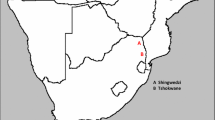Abstract
One hundred forty-nine Anopheles gambiae s.l. and 260 A. funestus were collected from the field in Namawala, Tanzania in June 1994. The mosquitoes were dissected and examined for plasmodium oocysts using two microscopic techniques and the polymerase chain reaction (PCR) method. The oldest and simplest technique, the saline test, detected oocysts in 94 out of the 97 mosquitoes found to have oocysts by the more sensitive merbromin stain and PCR techniques. The saline test was found to be a sensitive and reliable field technique for detection of large Plasmodium oocysts in mosquitoes. The merbromin staining technique was as sensitive as PCR, detecting even small oocysts.
Résumé
Cent quarante-neuf Anopheles gambiae s.l. et deux cent soixante (260) A. funestus ont été collectées en juin 1994, dans un champ à Namawala en Tanzanie. Les moustiques étaient disséqués et examinés pour la détection des oocysts de Plasmodium par deux techniques microscopiques et par la méthode de réaction de la chaîne polymérase (RCP). L’emploi de la solution saline, une technique très ancienne et très simple, a permis de détecter des oocytes chez 94 des 97 moustiques ayant déjà témoigne de la présence des oocysts par les techniques très sensibles: les traces de merbromine et la RCP. Le test par la solution saline s’est révélé être une technique sensible et faible de terrain pour détecter de gros oocytes chez les moustiques infectés de Plasmodium. La technique des traces de merbromine était aussi sensible que la RCP détectant même les petits oocytes.
Similar content being viewed by others
References
Babiker H. A., Ranford-Cartwright L. C., Currie D., Charlwood J. D., Billingsley P., Teuscher T. and Walliker D. (1994) Random mating in a natural population of the malaria parasite Plasmodium falciparum. Parasitol. 109, 413–421.
Baker R. H. Jr (1993) Use of PCR in the field. Parasitol. Today 10, 117–119.
Baker R. H., Banchongaksorn T., Courval J. M., Suwonkerd W., Rimwungtragoon K., Srittong N. and Wirth D. F. (1994) DNA probes as epidemiologic tools for surveillance of Plasmodium falciparum malaria in Thailand. Int. J. Epidemiol. 23, 161–168.
Beier J. C, Oster C. N., Onyango F. K., Bales J. D., Sherwood J. A., Perkins P. V., Chumo D. K., Koech D. V., Whitmire R. E., Roberts C. R. and Diggs C. R. (1994) Plasmodium falciparum incidence relative to entomological inoculation rates at a site proposed for testing malaria vaccines in western Kenya. Am. J. Trop. Med. Hyg. 50, 529–536.
Burkot T. R., Zavala F., Gwadz R. W., Collins F. W., Nussenzweig R. S. and Roberts D. R. (1984) Identification of malaria infected mosquitoes by a two-site enzyme-linked immunosorbent assay. Am. J. Trop. Med. Hyg. 33, 227–231.
Edoh D. (1995) Rejoinder: The use of PCR in the field. Parasitol. Today 11, 68.
Githeko A. K., Brandling-Bennett A. D., Beier M., Atieli F., Owaga M. and Collins F. W. (1992) The reservoir of Plasmodium falciparum in a holoendemic area of western Kenya. Trans. R. Soc. Trop. Med. Hyg. 86, 355–358.
Kain K. C. and Lanar D. E. (1991) Determination of genetic variation within Plasmodium falciparum by using enzymatically amplified DNA from filter paper disks impregnated with whole blood. J. Clin. Microbiol. 26, 1171–1174.
Ranford-Cartwright L. C., Balfe P., Carter R. and Walliker D. (1991) Genetic hybrids of Plasmodium identified by amplification of genomic DNA from single oocysts. Mol. Biochem. Parasitol. 49, 239–244.
Ranford-Cartwright L. C., Balfe P., Carter R. and Walliker D. (1993) Frequency of cross-fertilization in thehuman malaria parasite Plasmodium falciparum. Parasitol. 107, 11–18.
Rodgers M. R., Popper S. J. and Wirth D. F. (1990) Amplification of kinetoplast DNA as a tool in the detection and diagnosis of Leishmania. Exp. Parasitol. 71, 267–275.
Smith T., Charlwood J. D., Kihonda J., Mwankuyse S., Billingsley P., Meuwissen J., Lyimo E., Takken W., Teuscher T. and Tanner T. (1993) Absenceof seasonal variation in malaria parasitaemia in an area of intense seasonal transmission. Acta Tropica 54, 55–57.
Snounou G., Pinheiro L., Goncalves L., Fonseca L., Dias F., Brown K. N. and doRosario V. E. (1993) The importance of sensitive detection of malaria parasites in the human and mosquito hosts in epidemiological studies, as shown by the analysis of field samples from Guinea Bissau. Trans. R. Soc Trop. Med. Hyg. 87, 649–653.
Tassanakajon A., Boonsaeng V., Wilairat P. and Panyim S. (1993) Polymerase chain reaction detection of Plasmodium falciparum in mosquitoes. Trans. R. Soc. Trop. Med. Hyg. 87, 273–275.
Tirasophon W., Tassanakajon A., Boonsaeng V., Panyim S. and Wilairat P. (1993) Sensitive detection of Plasmodium falciparum in blood and mosquito by DNA amplification. Trans. R. Soc. Trop. Med. Hyg. 35, 117–120.
Vaughan J., Noden B.H.and Beier J. C. (1994) Sporogonie development of cultured Plasmodium falciparum in six species of laboratory-reared Anopheles mosquitoes. Am. J. Trop. Med. Hyg. 51, 233–243.
Zavala F., Gwadz R. W., Collins F. H., Nussenzweig R. S. and Nussenzweig V. (1982) Monoclonal antibodies to circumsporozoite proteins identify the species of malaria parasite in infected mosquitoes. Nature 299, 737–738.
Zimmerman P. A., Dadzie R. Y., De Sole G., Rema J., Soumbey E. and Unnasch T. R.(1992) Onchocerca volvulus DNA probes classification correlates with epidemiological patterns of blindness. J. Infect. Diseases 165, 964–968.
Author information
Authors and Affiliations
Corresponding author
Rights and permissions
About this article
Cite this article
Edoh, D., Haji, H. Comparison of Three Methods for Detection of Plasmodium Oocysts in Wild-Caught Mosquitoes. Int J Trop Insect Sci 18, 113–117 (1998). https://doi.org/10.1017/S1742758400007748
Accepted:
Published:
Issue Date:
DOI: https://doi.org/10.1017/S1742758400007748




